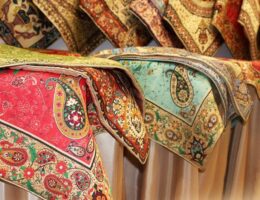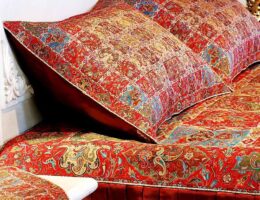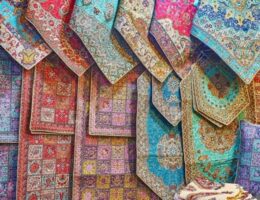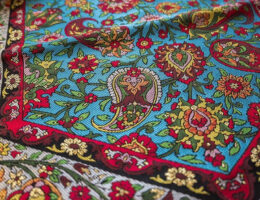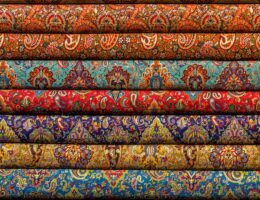IRAN ART EXHIBITION: KNITTING IS ART OF THREADS AND NEEDLES
Knitting is a fiber art in which loops of yarn are interlocked with the assistance of specially designed needles. Europeans have been knitting since around the 15th century, when both Italy and Spain started the practice, and it quickly spread. Modern knitting can be accomplished by hand with the use of traditional needles, or on knitting machines which have mechanized the process. Chances are that you are probably wearing a knit garment right now, thanks to the ubiquity of this popular method for making textiles.
One of the most convenient things about knitting is that it does not require extensive tools. The only simpler textile art is probably crochet, in which loops of yarn are knotted with a crochet hook. The simplicity of knitting makes it a very easy skill to teach, and an affordable art to practice. In order to knit a basic garment, all that is needed is a pair of knitting needles and a selection of yarn.
Novelty yarns, like eyelash yarn, are often the most difficult to work with. Knitting needles come in a range of styles. Traditional needles were once made from bone; various woods and metals are most common now. Straight knitting needles have one pointed end and one flat end, which often includes a bulb or ornamental device to keep the knitting from sliding off as it is worked. Double ended knitting needles, used for projects like turning sock heels and making hats, have, as one might imagine, two sharp ends, allowing the knitting to be worked from either side. Circular knitting needles are attached to each other; some knitters find this style more convenient for some projects. At its most basic, knitting involves repeatedly knotting yarn with two sticks or needles.
Yarn also comes in a dizzying assortment of fashions, from plain worsted weight wool to novelty yarns. Besides acrylic, yarn can be made from a huge variety of animal and plant fibers such as wool, silk, cotton, bamboo, soy, or corn, and it may be smooth, fuzzy, dyed, or plain. Very fine yarns can be used for projects like socks and delicate shawls, while thick, chunky yarns can be used to make creative hats, gloves, and scarves.
Knitting is accomplished by looping the yarn together in a series of stitches. Two basic stitches, the knit and the purl, make up the basis of all knitting. By manipulating these stitches, people can create ribbing, cabling, open lace, and a variety of other looks. Knitting can be done “in the round” on circular or double pointed needles to create seamless garments, or in the flat, in which case individual sections of a pattern are finished off and then stitched together.
There are many types of yarn a person can use for knitting.
Many people find knitting relaxing and enjoyable. If you are interested in learning how to knit, you can probably find a friendly knitter’s circle in your area which will teach you the basics and mentor you as you work on projects. Be warned that knitting can be highly addictive, especially if you have access to a good yarn store; but it can be put to good use. Hand-knitted gifts are often greatly appreciated, and you can also donate knitted goods to charitable organizations who will distribute them to people in need.
IRAN ART EXHIBITION: Years ago in some parts of Europe, knitting was a necessary part of life. Usually heavy woolen socks and undergarments were knitted for cold winter days. Not only were the garments knitted, but the yarn had to be prepared from the sheep’s wool. The wool would be first washed, dried, then fluffed up. All of this was done by hand. After that, a bundle of wool would be placed on one side of a stick about a yard or so long, and about one inch in diameter. The bottom of the stick was held under one arm and the part with wool was sticking away from you. You would start making the yarn by pulling on the wool a little at a time and twisting it with your fingers. There was another piece of elliptical shaped smooth wood, where the thread would be attached too, and was hanging toward the ground. As the yarn was growing you would wind it up on the elliptical shaped wood, and continued the process until the bundle was done.
When you had sufficient yarn for your project, it was time to start knitting. It used to be somewhat of a social event too, since women could prepare the yarn, or knit in the company of other women and chat at the same time. Usually this was an evening activity, when all the other daily chores were done.
Knitting Definition
What is knitting? Knitting is a kind of fiber craft where a thread of yarn is woven into a series of loops to create fabric. Usually, knitting can be done with just two needles and a ball of yarn, making it one of the most accessible forms of textile craft. There are several different types of knitting, meaning that the knitting definition is broad. It is also a highly versatile craft that can produce a wide variety of end products. Socks, sweaters, scarves, gloves, and hats are common garments that lend themselves well to knitting.
Knitting is a form of textile creation that is very different from the creation of woven fabrics. Weaving usually requires a loom or other heavy equipment and involves making fabric with a much higher number of threads and a much closer weave. Knitted fabrics tend to be stretchier and heavier than woven ones, with a very different texture.
When Was Knitting Invented?
Evidence of knitted fabrics dates back to around the fifth century CE. Some of the oldest knitted artifacts were found in Egypt, but while archaeologists are not certain exactly where knitting originated, they suspect that it originally came from the Middle East. Early knitting was probably done using cotton yarn instead of wool, although wool is by far the most common knitting fiber today.
IRAN ART EXHIBITION: Knitting spread around the world and became popular in Europe, especially in colder areas where heavy, knitted fabrics provided much-needed warmth. In the fourteenth century, knitting guilds were established in some parts of Europe. They were open only to men and they aimed to create increasingly intricate knitwear for the upper classes. The first knitting machines, which sped up the process of textile creation significantly, were in use by the sixteenth century.
The Knitting Process
Knitting usually involves two needles and a ball of yarn, though some techniques use many colors of yarn and many needles. Needles come in different sizes, which correspond roughly to the size of the loops they will produce. Likewise, yarn can be extraordinarily thin or very bulky, which will also impact the texture and weight of the finished garment. Finding the right needles and wool for a particular project is an important starting step in the process.
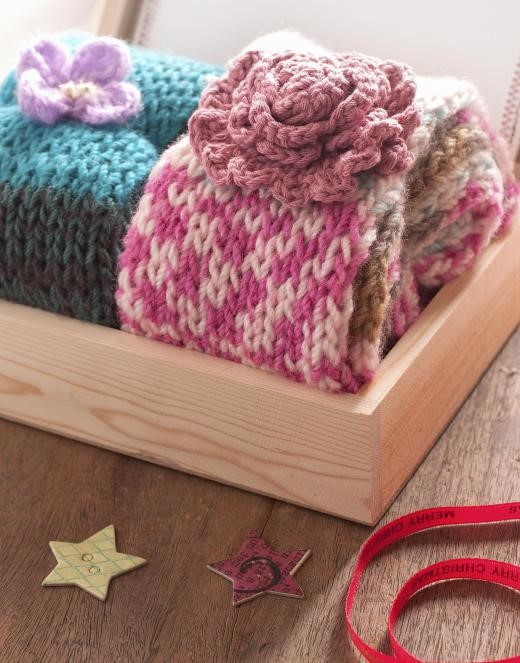
Casting On
When starting a project, the first thing that a knitter has to do is called casting on. This is the process of attaching the wool to one of the needles so that it can be woven into stitches. To begin, a knitter will tie a loop of yarn to the needle and then continue looping and knotting the yarn to create a first row of stitches. The number of loops cast on will be the number of stitches a knitter has to work with as they start their piece. There are several different ways to cast on and knitters usually have a specific style that they prefer.
Two Basic Stitches
IRAN ART EXHIBITION: Knitting might look complicated at first, but the reality is that the vast majority of knitting is done with just two basic stitches. The first is called a knit stitch. It is the fundamental stitch in knitting and nearly all patterns use it. In a knit stitch, every stitch connects to the one beside it with the free yarn being held behind the knitting needles. Knitting whole rows back and forth with just this one stitch results in what is called garter stitch, which looks the same on both sides.
The other main knitting stitch is the purl stitch. The process of purling is almost the same as knitting, but the yarn is kept in front of the needles. Knitting alternating rows of knit and purl stitches results in stockinette stitch. This produces a fabric that is smooth on one side and wavy on the other and it can be found in many pieces of knitwear. Knit and purl stitches can be combined in a variety of ways to create different patterns.
Frequently Asked Questions
What is the process of knitting?
Knitting involves getting the right needles and yarn, casting on, and then using a variety of stitches to complete a pattern. When the pattern is complete, knitters cast off and tie the end of the yarn to create a finished work.
What does knitting mean?
Knitting is a kind of textile work where a thread of yarn is looped and tied together to create a piece of fabric. It is commonly used to make warm garments like scarves and sweaters.
What is the most common type of knitting?
The most common style of knitting in many parts of the world is English knitting, where the yarn is held in the right hand. Other parts of the world use Continental, Lever, Portuguese, or Shetland styles.

